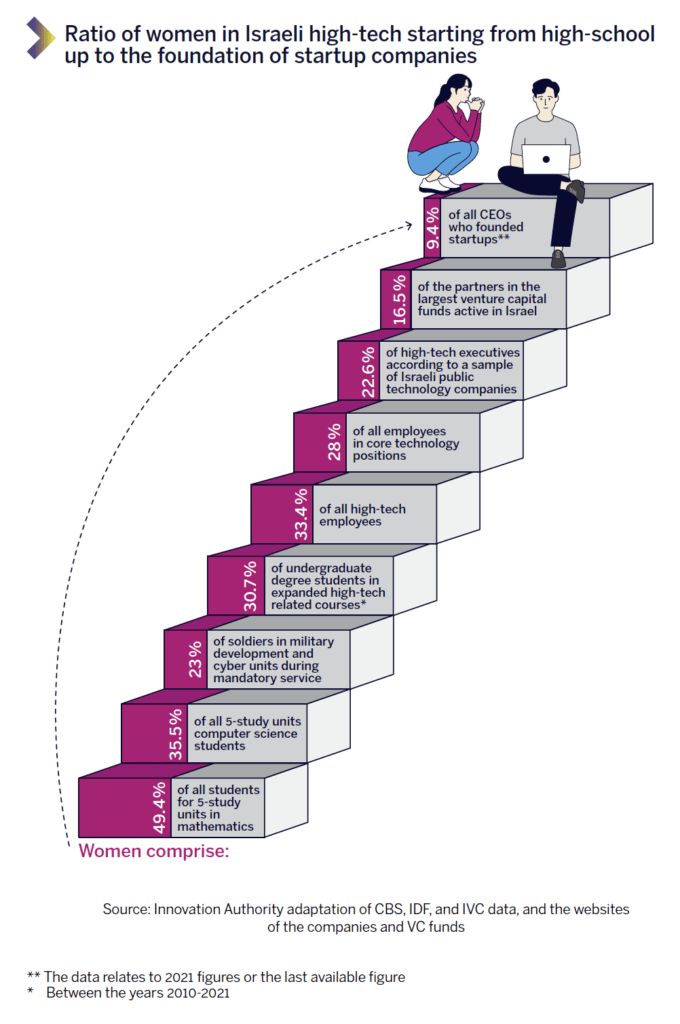A new report by the Israel Innovation Authority highlighting Israeli women in high tech published on International Women’s Day shows that while female students pursuing STEM subjects in school have the same educational opportunities as their male counterparts from elementary through high school, the gender gap widens through university, military service, and employement, and women are still heavily underrepresented in Israel’s high-tech workforce.
The first integrative report of its kind by the Israel Innovation Authority looks at the low participation rate of women in Israeli high-tech, postulates the reasons for this low participation, and then offers recommendations and possible solutions that can be taken by the government, the education system, and the local tech sector.
“Women represent only 23 percent of jobs in development and cyber roles in the IDF; women make up only 30.7 percent of university students studying high-tech; only 16.5 percent of leaders of Israeli investment bodies are women; and only 9.4 percent of startups were established by female entrepreneurs. In order to create change, there needs to be a concerted, joint effort by the high-tech industry and all relevant government stakeholders. This is the shared responsibility of all parties in the ecosystem,” Dror Bin, CEO of the Israel Innovation Authority said.

In high school, the results are encouraging. The report shows that 49.4 percent of students — or 9,000 females learn the five units of mathematics to take the matriculation exam, while 35 percent take the matriculation exam in computer science. While the report says this is a low number compared to the number of men who take, the number has steadily climbed since about 31 percent in 2016. According to the report, the subjects chosen by students at this stage of their lives influence the fields they will study later in life. According to the Central Bureau of Statistics, 30 percent of female students ho are eligible for the matriculation certificate in science-oriented subjects (primarily math and science) continue to an academic degree in a STEM study course. In other words, the tendency of female students who graduate with a matriculaton certificate in math and science subects to continue to undegraduate academic studies in STEM subjects, is six times higher than female students graduating with a matriculation certificate in other subjects.
While the choice of female students do impact the gender balance of the potential future high-tech workforce, the number take a significant drop with the miltary and later on, the high-tech workforce.

Military service is an important “launchpad” to the high-tech industry because it provides professional networks, experience and training, but according to the IIA report, only 31 percent of those serving in computer and software roles were women, and the rate of women in core technological roles – cyber and development – was only 23 percent.
This is lower than the rate of women in core technology roles. The proportion of women employed in high-tech has hardly changed over the last three decades, holding steady at one third of the positions in high-tech. Meanwhile, only 22.6 percent of women are in senior management roles in the Israeli high-tech industry and just 9.4 percent of those women are startup founders and CEOs, between 2010 and 2021, the report said.
NoCamels spoke with Dr. Ami Applebaum, chief scientist and chairman of the board at Israel Innovation Authority, who said the report was a “wake-up call” and that we need to get the government and other relevant parties.
“It’s not just a problem of the tech sector. You can’t point fingers. It’s a multifacted problem — it doesn’t come from just one place,” he explains.
Sign up for our free weekly newsletter
SubscribeFor his part, Dr. Applebaum says that while the gender gap in high school between men and women in STEM subjects isn’t very high, the reasons behind why many women don’t eventually enter the high-tech workforce, or even do anything with STEM matriculation exams or STEM degrees, starts much younger, with families.
“The problem starsts before the matriculation exams, before elementary school — it starts with family. Girls are getting the impression at a young age that they shouldn’t go for STEM fields because their families don’t encourage them to do so. Many families don’t realize or don’t understand that STEM is just as much a women’s field as it is a man’s, because that’s not how they grew up,” he says.
Dr. Applebaum suggests encouraging girls from a young age to play with educational toys that would later motivate them towards these fields and also to find female role models.

The Israel Innovation Authority offers other solutions and recommendations – not necessarily related to age – in the report. They suggest the establishment of programs to encourage teenage female students to mathematics, technology, and science in school; proactive activities to increase the number of women serving in core technology roles in the military, including developers and cyber; setting quantative targets to increase the number of female students for subjects that are related to the high-tech industry; and establishing supportive regulation in the labor market to facilitate the integration of women, especially mothers, in the industry.
The Israel Innovation Authority will expand its efforts to encourage female startup entrepreneurs to apply for grants, as the report also shows that fewer women are likely to request grants from the IIA even although the rate of approval is similar for men and women.
“Ever since taking office at the Ministry of Innovation, Science and Technology, we have been working together with the Innovation Authority to face these challenges and bring about real change. We have set clear goals to increase the number of women in high-tech within two years, as well as to increase the number of women in the Authority’s training programs to 45 percent,” said Orit Farkash-HaCohen, minister for science, technology and space. “The Innovation Authority has a variety of tools to promote this important issue – and together we will bring change. The Science Ministry has doubled the programs aimed at advancing future female scientists, and programs promoting excellence in teenage girls in the field of engineering and exact sciences.”
“Understanding the challenges we face – which this report does – will enable us to formulate actions that will bring about real, positive change in this sector. I believe all parts of government should work together on this highly important issue,” she added.
The Israel Innovation Authority report was conducted in collaboration with the Women in High-Tech Initiative.
Related posts

Editors’ & Readers’ Choice: 10 Favorite NoCamels Articles

Forward Facing: What Does The Future Hold For Israeli High-Tech?

Impact Innovation: Israeli Startups That Could Shape Our Future




Facebook comments